BRE/BRCC45 regulates CDC25A stability by recruiting USP7 in response to DNA damage
- PMID: 29416040
- PMCID: PMC5803202
- DOI: 10.1038/s41467-018-03020-6
BRE/BRCC45 regulates CDC25A stability by recruiting USP7 in response to DNA damage
Abstract
BRCA2 is essential for maintaining genomic integrity. BRCA2-deficient primary cells are either not viable or exhibit severe proliferation defects. Yet, BRCA2 deficiency contributes to tumorigenesis. It is believed that mutations in genes such as TRP53 allow BRCA2 heterozygous cells to overcome growth arrest when they undergo loss of heterozygosity. Here, we report the use of an insertional mutagenesis screen to identify a role for BRE (Brain and Reproductive organ Expressed, also known as BRCC45), known to be a part of the BRCA1-DNA damage sensing complex, in the survival of BRCA2-deficient mouse ES cells. Cell viability by BRE overexpression is mediated by deregulation of CDC25A phosphatase, a key cell cycle regulator and an oncogene. We show that BRE facilitates deubiquitylation of CDC25A by recruiting ubiquitin-specific-processing protease 7 (USP7) in the presence of DNA damage. Additionally, we uncovered the role of CDC25A in BRCA-mediated tumorigenesis, which can have implications in cancer treatment.
Conflict of interest statement
The authors declare no competing financial interests.
Figures
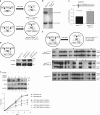
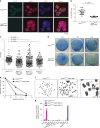
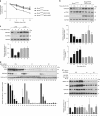
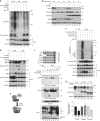

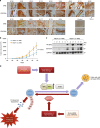
Similar articles
-
Ubiquitin hydrolase Dub3 promotes oncogenic transformation by stabilizing Cdc25A.Nat Cell Biol. 2010 Apr;12(4):400-6. doi: 10.1038/ncb2041. Epub 2010 Mar 14. Nat Cell Biol. 2010. PMID: 20228808
-
Ubiquitin-Specific Protease 29 Regulates Cdc25A-Mediated Tumorigenesis.Int J Mol Sci. 2021 May 28;22(11):5766. doi: 10.3390/ijms22115766. Int J Mol Sci. 2021. PMID: 34071237 Free PMC article.
-
Acetylation and deacetylation of Cdc25A constitutes a novel mechanism for modulating Cdc25A functions with implications for cancer.Oncotarget. 2016 Apr 12;7(15):20425-39. doi: 10.18632/oncotarget.7966. Oncotarget. 2016. PMID: 26967250 Free PMC article.
-
The cancer connection: BRCA1 and BRCA2 tumor suppression in mice and humans.Oncogene. 2002 Dec 16;21(58):8994-9007. doi: 10.1038/sj.onc.1206177. Oncogene. 2002. PMID: 12483515 Review.
-
Lessons learned from BRCA1 and BRCA2.Oncogene. 2000 Dec 11;19(53):6159-75. doi: 10.1038/sj.onc.1203968. Oncogene. 2000. PMID: 11156530 Review.
Cited by
-
SNHG15-mediated feedback loop interplays with HNRNPA1/SLC7A11/GPX4 pathway to promote gastric cancer progression.Cancer Sci. 2024 Jul;115(7):2269-2285. doi: 10.1111/cas.16181. Epub 2024 May 8. Cancer Sci. 2024. PMID: 38720175 Free PMC article.
-
Essential role of the BRCA2B gene in somatic homologous recombination in Arabidopsis thaliana.BioTechnologia (Pozn). 2023 Dec 21;104(4):371-380. doi: 10.5114/bta.2023.132773. eCollection 2023. BioTechnologia (Pozn). 2023. PMID: 38213474 Free PMC article.
-
Deubiquitylating Enzymes in Cancer and Immunity.Adv Sci (Weinh). 2023 Dec;10(36):e2303807. doi: 10.1002/advs.202303807. Epub 2023 Oct 27. Adv Sci (Weinh). 2023. PMID: 37888853 Free PMC article. Review.
-
Babam2 negatively regulates osteoclastogenesis by interacting with Hey1 to inhibit Nfatc1 transcription.Int J Biol Sci. 2022 Jul 11;18(11):4482-4496. doi: 10.7150/ijbs.72487. eCollection 2022. Int J Biol Sci. 2022. PMID: 35864959 Free PMC article.
-
PPDPF Promotes the Progression and acts as an Antiapoptotic Protein in Non-Small Cell Lung Cancer.Int J Biol Sci. 2022 Jan 1;18(1):214-228. doi: 10.7150/ijbs.65654. eCollection 2022. Int J Biol Sci. 2022. PMID: 34975328 Free PMC article.
References
-
- Murphy KM, et al. Evaluation of candidate genes MAP2K4, MADH4, ACVR1B, and BRCA2 in familial pancreatic cancer: deleterious BRCA2 mutations in 17% Cancer Res. 2002;62:3789–3793. - PubMed
Publication types
MeSH terms
Substances
LinkOut - more resources
Full Text Sources
Other Literature Sources
Molecular Biology Databases
Research Materials
Miscellaneous


